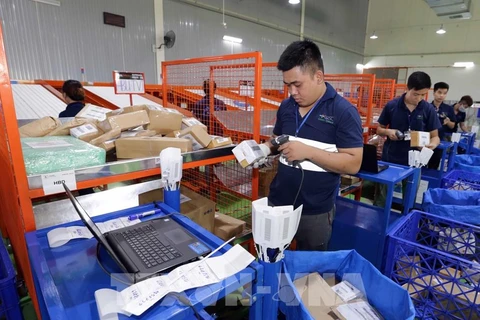 Garments made for export to South Korea. The application of technology platforms in Vietnam’s exports has witnessed remarkable progress in comparison with other countries in the region. (Photo:VNA)
Garments made for export to South Korea. The application of technology platforms in Vietnam’s exports has witnessed remarkable progress in comparison with other countries in the region. (Photo:VNA) Hanoi (VNS/VNA) - Using online platforms to boost exports is the fastest way to bring Vietnamese goods to the world, said business leaders and industry experts.
The COVID-19 pandemic has heavily affected business operations. But there are still opportunities for businesses to use online channels to deeply participate in the global supply chain, as most buyers in the world are searching for products through search engines or e-commerce platforms.
Tran Xuan Thuy, Amazon Global Selling Vietnam’s Country Director, said the world’s e-commerce revenue would reach more than 3.3 trillion USD in 2020. By 2022, the growth rate of e-commerce would exceed the growth rate of offline sales.
He added that on the Amazon platform, there are small and medium enterprises in Vietnam starting with only two people, now exporting goods to 30 countries, and opening 4-5 factories in the country.
A representative from Thach Ban Group specialising in construction material production said their export volume used to account for only 5-7 percent. However, online exports helped their volume increase to 13 percent in 2019.
Vu Tu Thanh, Deputy Director of the US-ASEAN Business Council (USBAC), said the application of technology platforms in Vietnam’s exports has made remarkable progress in comparison with countries around the region.
He said he was surprised to find Thailand’s application of e-commerce in exports was not as high as Vietnam because their physical trade is good. So, the motivation for conversion is not as much as in Vietnam. This is an opportunity to boost exports of Vietnamese products all over the world.
Vu Tien Loc, Chairman of Vietnam Chamber of Commerce and Industry (VCCI), said previously, import and export activities were only for large-scale enterprises with high economic and financial potential. They became big firms thanks to imports and exports and dominate many fields of production and business. Today, online exports have completely changed this trend. Micro and small businesses also have an equal opportunity to reach global trade.
However, participation in this new global supply chain also faces many limitations and risks, becoming a barrier for Vietnamese consumers. Both buyers and sellers have difficulty in language and business culture. In particular, buyers often have difficulty in international payments as the number of Vietnamese people with international payment cards such as Visa and Mastercard remains low.
In addition, there are risks with billions of diversified products, designs, quality and reputable sellers on international e-commerce sites.
Thuy said local firms should build a professional sales team to serve foreign customers.
Before making a big trade decision, it is necessary to seek legal advice, as well as ensure consistent and strict contract terms. This will help businesses avoid risks and fraud.
Hoanh Manh Hue, Chairman of the Union of Vietnamese Business Associations in Europe, said Vietnamese firms have many strengths when joining the EU-Vietnam Free Trade Agreement (EVFTA). Enterprises transforming to e-commerce sales are required to transform business forms, building a professional sales team from packaging to interacting with customers.
Dang Hoang Hai, Director of Vietnam's e-Commerce and Digital Economy Agency under the Ministry of Industry and Trade (MoIT), said it is not easy to build a legal framework for cross-border activities, even in countries with advanced legal systems.
The ministry is building a legal framework for products with advantages then gradually adjusting to suit the market. Policies facilitating firms in implementing e-commerce would continue to be built together with forums and exhibitions to promote exports./.
VNA
























